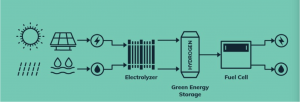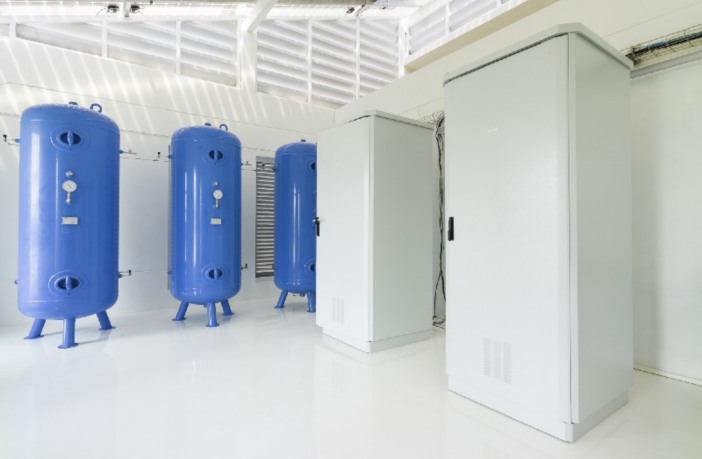Opinion
Energy production is becoming increasingly decentralised. The relationship between users and producers is shifting: it is getting more intimate. Users are empowered to choose their energy source and harness their independence.
Hydrogen is ready for the future of energy and enables long-term energy independence and security. Technology barriers have fallen and the cost barriers to renewable hydrogen gen- eration are falling as players scale operation.

Pic: Green H2 Process. Credit: Enapter
We speak about the energy transition away from fossil fuels, but some markets are still in the transition to electrification. Existing grids in developed nations demonstrate an inefficient infrastructure, so the emerging markets have the chance to leapfrog into better setups. With the rise of renewables, there is a widespread need for storage. Several solutions like hydrogen or batteries come up, and we should optimise their strengths in sector-coupling.
Collaboration is key
The energy transition cuts across industries and no single technology alone will enable us to accomplish our goals for decarbonisation. Hydrogen therefore appears to be a great demonstrator for cross industry collaboration: it is a versatile energy carrier, easily stored as a gas, ef cient in a multitude of applications. Made from 100% renewable electricity, it allows large amounts of renewables to be channelled from the power sector into transport, buildings and industry.
We can use hydrogen to decarbonise our power and heat consumption. As a fuel, we can transport it or use it in mobility applications like trains, trucks or ships. Hydrogen also nds its place in industry processes or fertiliser production. 95% of hydrogen is currently made from fossil fuels; and the largest share of hydrogen demand is from the chemicals sectors for the production of ammonia in re ning for hydrocracking and desulfurisation of fuels. Moreover, a majority of the world’s fertiliser is derived from ammonia produced in the Haber-Bosh process, which uses hydrogen derived from steam reformation. If such consumers of grey hydrogen invest in green methods of hydrogen production, they will decrease their CO2 emission, reduce their costs in the long term, but also scale the technology for the society. Whether it’s an exchange of knowledge, equipment or capital, this is a win-win situation for all parties.
Hydrogen is ideal for seasonal storage
In New Jersey, the Hydrogen House Project synchronises itself to earth’s cycles. When the days get longer, it capitalises on solar exposure for the production of Hydrogen; up until the summer solstice in June. When Hurricane Sandy hit the United States, the power went out in many homes. The Hydrogen House Project has 120 days’ worth of storage. Hydrogen can be stored in large quantities, and for limitless time. When one produces hydrogen in the summer, they can keep going through the winter, or rainy season like at the Phi Suea House in Thailand. In Chiang Mai, this home has 36 hours of back up energy, which is more than enough in this application; and more than the conventional battery’s storage capacity.
Remote locations — that often rely on a diesel generator — have the opportunity to cut their dependence from fossil fuels and switch to clean energy. Importing the fuel requires transportation and a whole supply chain that emits CO2 without consider- ing the noise and actual pollution that takes place when energy is then generated.
Cutting their reliance of diesel, sites become energy dependent and energy secure. We can create microgrids, neighbourhoods that produce and use hydrogen for energy storage. This is only a piece of the puzzle to paint the full picture of a sustainable community. Independence comes in forms other than energy; it involves nutrition and water too. There is a rise in designing self-suf cient lifestyles, in the form of co-operatives or eco-village luxury holiday houses. Decentralising consumption to an onsite production of resources empowers each individual. One knows the origin of their product and chooses to invest in this knowledge. With such a mindset comes the concept of sharing and exchanging. Surely there are times where supply exceeds our demand. Co-depending on our peers strengthens the community, so an easy exchange mechanism is key.
The future of energy is digital
Away from the traditional grid and transportation losses, decentralised microg- rids are also smart grids. A smart meter becomes the hub for communication and exchange between the household’s demand and supply of energy. This can also include hydrogen energy storage and opens up new collaboration and business model opportunities too.
Once our basic needs are met, our mobility ones can also be fueled by hydrogen. Our vision of a fully independent lifestyle, based on hydrogen, is to have in these communities, or in our home, a refuelling station. Since hydrogen is produced on- site by renewables, imagine having a refuelling station nearby too. A full tank only takes three minutes to ll up. Your whole lifestyle becomes carbon-free. We believe hydrogen will be the driver for a clean, independent and energy secure future.
Author: Vaitea Cowan
Vaitea is the Co-Founder of Enapter, a company that scales decentralised green hydrogen solutions.











